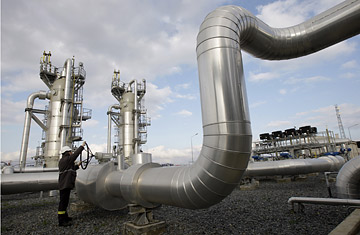
A Turkish technician checks the valves at a natural gas storage facility in Silivri, near Istanbul, Turkey
Moscow sent a chilly reminder, over the New Year, of the urgency behind Europe's quest to wean itself off a dependence on Russian natural gas. Millions of Germans, Slovaks, Bulgarians, Moldovans and Italians were left without heat for a week in sub-zero temperatures, as a result of a commercial dispute between Russia and Ukraine — Moscow had turned off the gas supply piped across the vast former Soviet Republic, hoping to turn up the heat on the Western-aligned government in Kiev by turning off the heat in Europe. Restarting the flow required urgent diplomatic shuttling by German Chancellor Angela Merkel and other European leaders. But as much as the episode highlighted the problem of depending on energy supplies from an increasingly churlish Russia, finding alternative supply sources will be far from simple.
About one-quarter of the European Union's gas supplies come from Russia's energy behemoth Gazprom, and of that about 80% is delivered across Ukraine, using pipeline routes that date to Soviet times. And as relations between Russia and Ukraine have begun to fray since the election of the pro-NATO President Viktor Yushcenko in 2004, so has the security of the trans-Ukraine gas supply come into question. "It is difficult to remove politics from anything to do with Ukraine and Russia," says Tim Gould, an analyst for the International Energy Agency in Paris.
That latest supply crisis erupted when Russia accused Ukraine of siphoning off about 115 million cubic meters of Russian gas — worth about $1.2 billion — from the pipeline running through its territory to European customers. Officials in Kiev insisted they were simply tapping the "technical gas" needed to keep the pipeline fired and running smoothly. Underlying the dispute, however, was a long-simmering disagreement over the price paid by Ukraine for its own gas imports from Russia. When Ukraine was ruled by a more Moscow-friendly administration Russia was willing to sell the country gas at a heavily discounted rate, but Russia now demands that Ukraine pay European-level rates of about $420 per 1,000 cubic meters — a steep increase over the current price of $179.50. Under the agreement brokered by European diplomats to end the shut-off, Ukraine will pay a price double that of the previous, subsidized rate.
While Gazprom may be feeling the pressure of the onset of a deep recession, its price dispute with Ukraine is grounded in Russian geopolitics. "There is a real sense Gazprom behaved in a way designed to embarrass Ukraine, rather than to get the gas flowing again," Julian Lee of the Center for Global Energy Studies in London told Reuters on Wednesday.
The problem facing Europe's consumer nations, however, is that there are precious few alternatives to buying Russian gas. European leaders have spent years developing plans to divert significant supplies of Caspian Sea natural gas from post-Soviet nations such as Kazakhstan and Turkmenistan. But the construction of such pipelines has lagged badly — and may be imperiled by the tensions in the Caucasus in the wake of last summer's Russia-Georgia showdown, which shut the Caspian oil pipeline running through Georgia from Azerbaijan to Turkey. A separate South Caucusus pipeline from Azerbaijan across Georgia still sends only a small quantity of gas to Europe, while the 2,000-mile Nabucco pipeline, which is intended to carry about 31 billion cubic meters of Caspian gas a year to Europe by 2020, also across Georgia, is still under construction. But Nabucco's supply is not entirely secure, with Russia and China looking to buy up the bulk of the gas being drilled out of the Caspian.
A third pipeline from Algeria, set to open later this year, will pump natural gas across the Mediterranean to Spain, but there is no pipeline to carry it beyond France.
Russia, meanwhile, wants to build new pipelines to Europe that bypass Ukraine. A new pipeline called Nord Stream will carry Russian gas under the Baltic Sea to the German coast by 2011, and Russia is planning a build a South Stream pipeline to Bulgaria. Still, the combined volume of gas that can be delivered through these two pipelines is less than is currently delivered via Ukraine.
Avoiding dependence on Russian supplies ultimately requires that Europe wean itself off of natural gas altogether by developing alternative energy sources. The continent already has about 197 nuclear power plants in operation, and last year's wild gyrations in world oil prices has spurred plans for for new nuclear reactors in several former Soviet republics, which are more dependent than the European Union is on Russian energy exports.
A European Union law passed last year commits member countries to getting 20% of its energy from renewable sources such as wind, tidal and solar power by 2020. But those plans are likely to cost billions, particular if they involve building new electricity grids to replace natural gas. "You hear a lot from the European Commission about using alternative fuels," says Simon Pirani of the Insitute for Energy Studies at Oxford. "In reality there are big questions about how to implement those plans given the economic situation." Until those questions are answered, many Europeans might shiver through more winters ahead.
